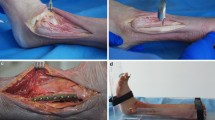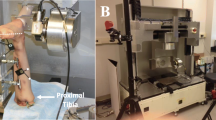Abstract
Purpose
Traditional studies of syndesmosis injury and screw stabilization have been conducted in cadaveric models, which cannot yield sufficient and exact biomechanical data about the interior of the ankle. The purpose of this study was to evaluate the effects of inferior tibiofibular syndesmosis injury (ITSI) and screw stabilization on the motion of the ankle with finite element analysis.
Methods
Three-dimensional models of the ankle complex were created with CT images of a volunteer’s right ankle in three states: normal, post-ITSI, and stabilization with a screw 2.5 cm above (parallel to) the ankle. Simulated loads were applied under three conditions: neutral position with single foot standing, internal rotation, and external rotation of the ankle.
Results
Compared with the normal state, ITSI increased the relative displacement between the lower extremes of the tibia and fibula in the anteroposterior and mediolateral directions and the angular motion of the tibia, fibula, and talus at internal and external rotations (ERs). However, when stabilized with syndesmotic screws, the range of motion (ROM) and all these parameters significantly decreased.
Conclusion
ITSI can lead to internal and ER instability of the ankle joint. Screw stabilization is effective in controlling the instability, but may reduce markedly the ROM of the ankle joint. Through this study, it can be proposed that the screws should be removed once the healing is gained in order to restore normal function of the ankle joint as soon as possible.





Similar content being viewed by others
References
Agur A, Lee M (1999) Grant’s atlas of human anatomy, 10th edn. Lippincott Williams and Wilkins, Philadelphia
Bauer AS, Blumanb EM, Wilsona MG, Chiodoa CP (2009) Injuries of the distal lower extremity syndesmosis. Curr Orthop Pract 20:111–116
Beumer A, van Hemert WL, Swierstra BA, Jasper LE, Belkoff SM (2003) A biomechanical evaluation of the tibiofibular and tibiotalar ligaments of the ankle. Foot Ankle Int 24:426–429
Boden SD, Labropoulos PA, McCowin P, Lestini WF, Hurwitz SR (1989) Mechanical considerations for the syndesmosis screw. A cadaver study. J Bone Joint Surg Am 71:1548–1555
Bray RC, Shrive NG, Frank CB, Chimich DD (1992) The early effects of joint immobilization on medial collateral ligament healing in an ACL-deficient knee: a gross anatomic and biomechanical investigation in the adult rabbit model. J Orthop Res 10:157–166
Cedell CA (1975) Ankle lesions. Acta Orthop Scand 46:425–445
Close JR (1956) Some applications of the functional anatomy of the ankle joint. J Bone Joint Surg Am 38:761–781
Dołzyński M, Latosiewicz R (1998) Rotatory instability of the ankle: an experimental investigation of tibio-fibular syndesmosis function. Chir Narzadow Ruchu Ortop Pol 63:451–454
Gardner MJ, Demetrakopoulos D, Briggs SM, Helfet DL, Lorich DG (2006) Malreduction of the tibiofibular syndesmosis in ankle fractures. Foot Ankle Int 27:788–792
Gefen A, Megido-Ravid M, Itzchak Y, Arcan M (2000) Biomechanical analysis of the three-dimensional foot structure during gait: a basic tool for clinical applications. J Biomech Eng 122:630–639
Hamid N, Loeffler BJ, Braddy W, Kellam JF, Cohen BE, Bosse MJ (2009) Outcome after fixation of ankle fractures with an injury to the syndesmosis: the effect of the syndesmosis screw. J Bone Joint Surg Br 91:1069–1073
Harper MC, Keller TS (1989) A radiographic evaluation of the tibiofibular syndesmosis. Foot Ankle 10:156–160
Hoefnagels EM, Waites MD, Wing ID, Belkoff SM, Swierstra BA (2007) Biomechanical comparison of the interosseous tibiofibular ligament and the anterior tibiofibular ligament. Foot Ankle Int 28:602–604
Hopkinson WJ, St Pierre P, Ryan JB, Wheeler JH (1990) Syndesmosis sprains of the ankle. Foot Ankle 10:325–330
Huiskes R (1982) On the modeling of long bones in structural analyses. J Biomech 15:65–69
Imhauser CW, Siegler S, Udupa JK, Toy JR (2008) Subject-specific models of the hindfoot reveal a relationship between morphology and passive mechanical properties. J Biomech 41:1341–1349
Liacouras PC, Wayne JS (2007) Computational modeling to predict mechanical function of joints: application to the lower leg with simulation of two cadaver studies. J Biomech Eng 129:811–817
Liu Q, Zhang K, Zhuang Y, Li Z, Yu B et al (2013) Analysis of the stress and displacement distribution of inferior tibiofibular syndesmosis injuries repaired with screw fixation: a finite element study. PLoS ONE 8:e80236
Moore JA Jr, Shank JR, Morgan SJ, Smith WR (2006) Syndesmosis fixation: a comparison of three and four cortices of screw fixation without hardware removal. Foot Ankle Int 27:567–572
Ogata K, Whiteside LA, Andersen DA (1980) The intra-articular effect of various postoperative managements following knee ligament repair: an experimental study in dogs. Clin Orthop Relat Res 150:271–276
Pfaeffle HJ, Tomaino MM, Grewal R, Xu J, Boardman ND et al (1996) Tensile properties of the interosseous membrane of the human forearm. J Orthop Res 14:842–845
Qamar F, Kadakia A, Venkateswaran B (2011) An anatomical way of treating ankle syndesmotic injuries. J Foot Ankle Surg 50:762–765
Rasmussen O (1985) Stability of the ankle joint. Analysis of the function and traumatology of the ankle ligaments. Acta Orthop Scand Suppl 211:1–75
Rasmussen O, Tovborg-Jensen I, Boe S (1982) Distal tibiofibular ligaments. Analysis of function. Acta Orthop Scand 53:681–686
Ruedi TP, Murphy WM (2000) AO principles of fracture management. AO Publishing, New York
Schepers T (2012) Acute distal tibiofibular syndesmosis injury: a systematic review of suture-button versus syndesmotic screw repair. Int Orthop 36:1199–1206
Siegler S, Block J, Schneck CD (1988) The mechanical characteristics of the collateral ligaments of the human ankle joint. Foot Ankle 8:234–242
Teramoto A, Kura H, Uchiyama E, Suzuki D, Yamashita T (2008) Three-dimensional analysis of ankle instability after tibiofibular syndesmosis injuries: a biomechanical experimental study. Am J Sports Med 36:348–352
van den Bekerom MP, Hogervorst M, Bolhuis HW, van Dijk CN (2008) Operative aspects of the syndesmotic screw: review of current concepts. Injury 39:491–498
van den Bekerom MP, Lamme B, Hogervorst M, Bolhuis HW (2007) Which ankle fractures require syndesmotic stabilization? J Foot Ankle Surg 46:456–463
Xu C, Zhang MY, Lei GH, Zhang C, Gao SG et al (2012) Biomechanical evaluation of tenodesis reconstruction in ankle with deltoid ligament deficiency a finite element analysis. Knee Surg Sports Traumatol Arthrosc 20:1854–1862
Acknowledgments
This work was supported by the Shaanxi Province Science Technology Research and Development Projects (No. 2011K12-05-13) and the Natural Science Foundation of China (No. 81071233). We also thank Professor Liang Allen Ping and Ms Zhang Yifang for their revision and editing of this manuscript.
Conflict of interest
The authors declare that they have no conflict of interest.
Author information
Authors and Affiliations
Corresponding author
Rights and permissions
About this article
Cite this article
Liu, Q., Zhao, G., Yu, B. et al. Effects of inferior tibiofibular syndesmosis injury and screw stabilization on motion of the ankle: a finite element study. Knee Surg Sports Traumatol Arthrosc 24, 1228–1235 (2016). https://doi.org/10.1007/s00167-014-3320-y
Received:
Accepted:
Published:
Issue Date:
DOI: https://doi.org/10.1007/s00167-014-3320-y




